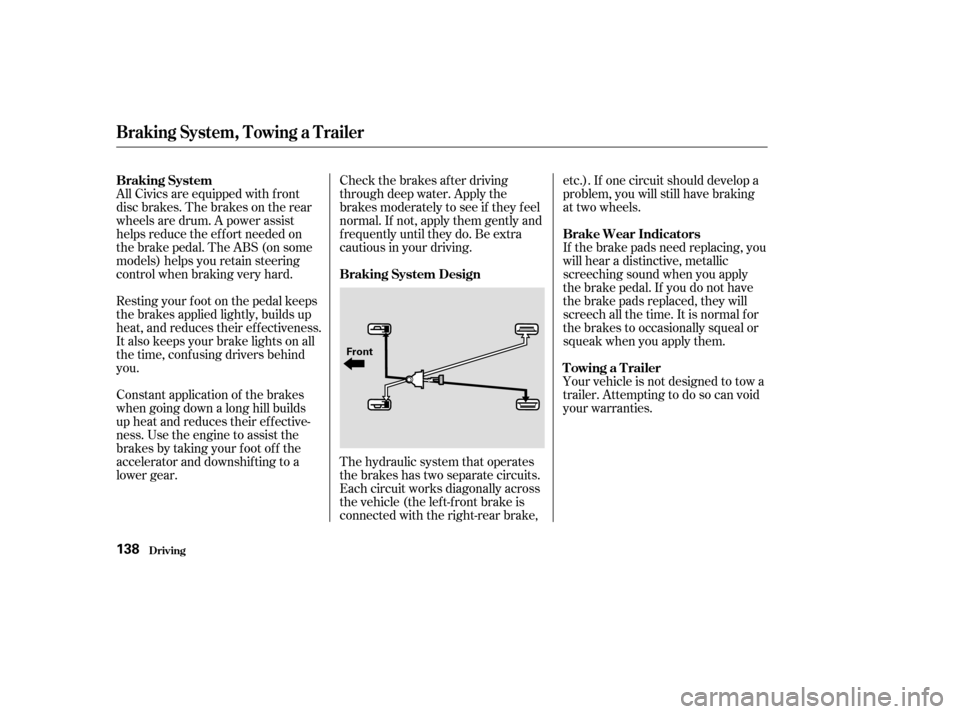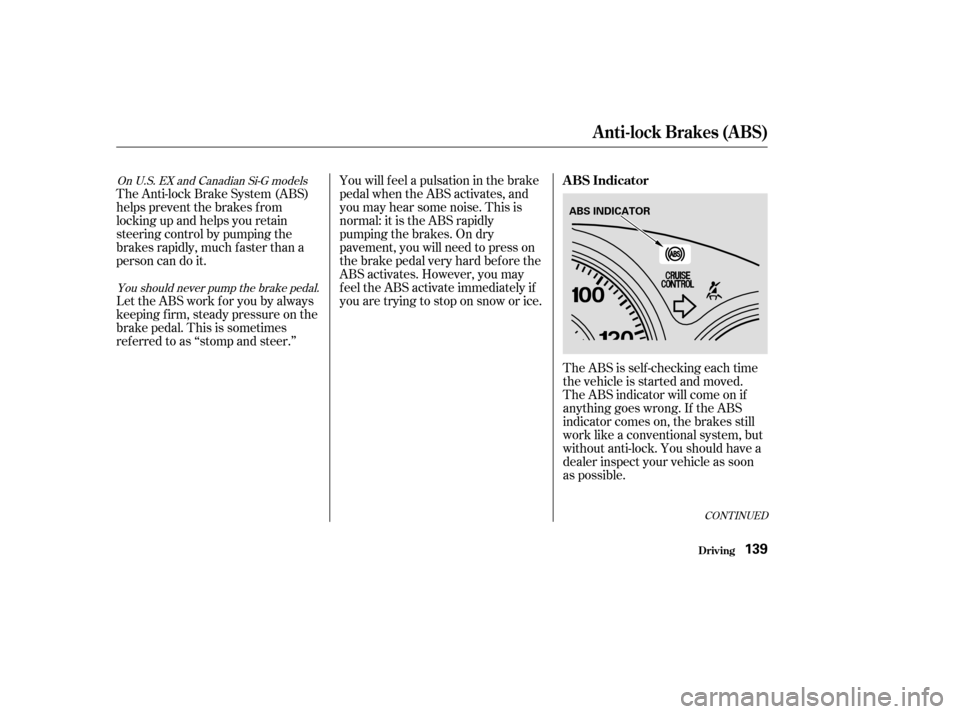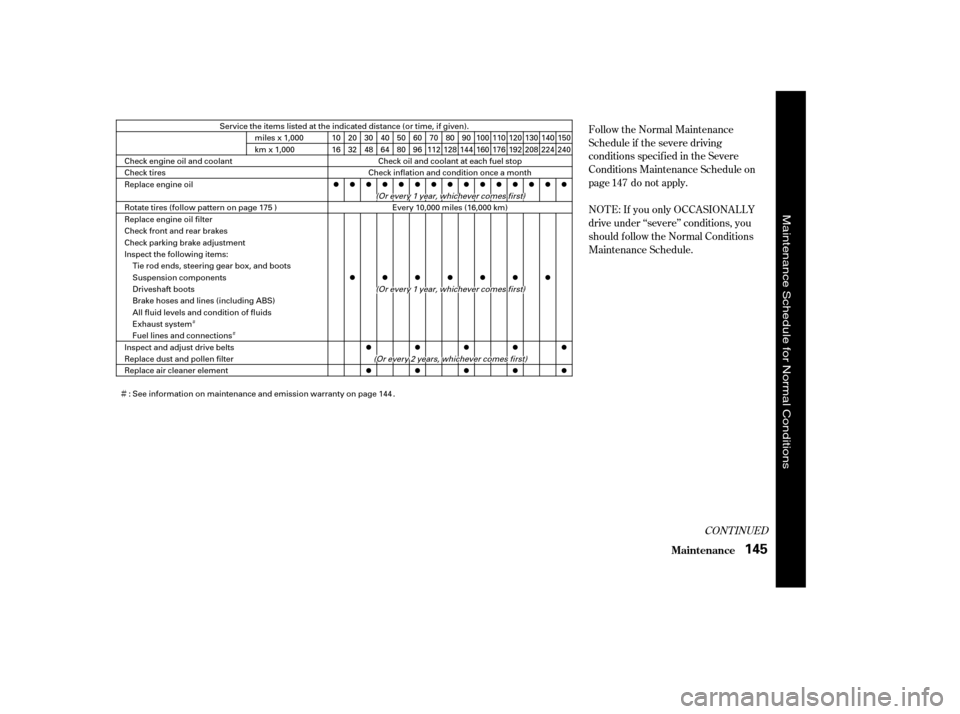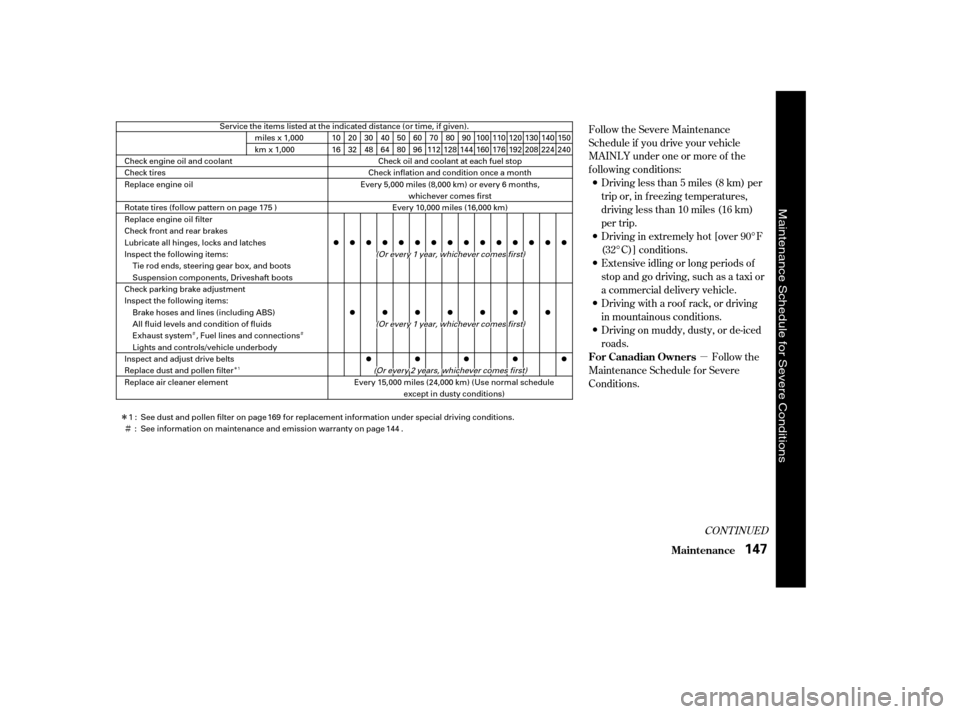Page 125 of 231
Fasten your seat belt. Check that
your passengers have f astened
their seat belts (see page ).
When you start the engine, check
the gauges and indicator lights in
the instrument panel (see page).
Make sure the doors are securely
closed and locked.
Check the steering wheel
adjustment (see page ).
Check the adjustment of the
inside and outside mirrors (see
page ).
Check that any items you may be
carrying are stored properly or
f astened down securely.
Check the seat adjustment (see
page ).
Youshoulddothefollowingchecks
and adjustments every day bef ore
you drive your vehicle.
Make sure all windows, mirrors,
and outside lights are clean and
unobstructed. Remove f rost, snow,
or ice.
Check that the hood and trunk are
f ully closed.
Visually check the tires. If a tire
looks low, use a gauge to check its
pressure.
1. 2. 3. 4.
9.
8.
7.
6.
5.
10.
76
83 68 14
53
Driving
Preparing to Drive
126
�����—�����—�����y�
�������������y���
�(���%�������y���
�����y
Page 137 of 231

Check the brakes after driving
through deep water. Apply the
brakes moderately to see if they f eel
normal. If not, apply them gently and
f requently until they do. Be extra
cautious in your driving.
All Civics are equipped with f ront
disc brakes. The brakes on the rear
wheels are drum. A power assist
helps reduce the ef f ort needed on
thebrakepedal.TheABS(onsome
models) helps you retain steering
control when braking very hard.
Resting your f oot on the pedal keeps
the brakes applied lightly, builds up
heat, and reduces their ef f ectiveness.
It also keeps your brake lights on all
the time, conf using drivers behind
you.
Constant application of the brakes
when going down a long hill builds
up heat and reduces their ef f ective-
ness. Use the engine to assist the
brakes by taking your f oot of f the
accelerator and downshif ting to a
lower gear.
The hydraulic system that operates
the brakes has two separate circuits.
Each circuit works diagonally across
the vehicle (the lef t-f ront brake is
connected with the right-rear brake,etc.). If one circuit should develop a
problem, you will still have braking
at two wheels.
If the brake pads need replacing, you
will hear a distinctive, metallic
screeching sound when you apply
the brake pedal. If you do not have
the brake pads replaced, they will
screech all the time. It is normal f or
the brakes to occasionally squeal or
squeak when you apply them.
Your vehicle is not designed to tow a
trailer. Attempting to do so can void
your warranties.
Braking System, Towing a Trailer
Driving
Braking System Design
Braking System
Brake Wear Indicators
Towing a Trailer
138
Front
�����—�����—�����y�
�������������y���
�(���%�������y���
���
�y
Page 138 of 231

The ABS is self -checking each time
the vehicle is started and moved.
The ABS indicator will come on if
anything goes wrong. If the ABS
indicator comes on, the brakes still
work like a conventional system, but
without anti-lock. You should have a
dealer inspect your vehicle as soon
as possible.
You will f eel a pulsation in the brake
pedal when the ABS activates, and
you may hear some noise. This is
normal: it is the ABS rapidly
pumpingthebrakes.Ondry
pavement, you will need to press on
thebrakepedalveryhardbeforethe
ABS activates. However, you may
feel the ABS activate immediately if
you are trying to stop on snow or ice.
The Anti-lock Brake System (ABS)
helps prevent the brakes f rom
locking up and helps you retain
steering control by pumping the
brakes rapidly, much f aster than a
person can do it.
Let the ABS work f or you by always
keeping f irm, steady pressure on the
brake pedal. This is sometimes
ref erred to as ‘‘stomp and steer.’’
CONT INUED
You should never pump the brake pedal.
On U.S. EX and Canadian Si-G models
Anti-lock Brakes (ABS)
Driving
ABS Indicator
139
ABS INDICATOR
�����—�����—�����y�
�������������y���
�(���%�������y���
�����y
Page 139 of 231
It only helps with the
steering control during braking.
such as trying to take a
corner too f ast or making a sudden
lane change. Always drive at a safe
speed f or the road and weather
conditions.
Always steer moderately
when you are braking hard. Severe
or sharp steering wheel movement
can still cause your vehicle to veer
into oncoming traffic or off the road. on loose or
uneven surf aces, such as gravel or
snow, than a vehicle without anti-
lock. Slow down and allow a greater
distance between vehicles under
those conditions.
Anti-lock Brakes (ABS)
Driving
Import ant Saf et y Reminders
A BS does not reduce the time or
distance it takes to stop the
vehicle.
A BS will not prevent a skid that
results f rom changing direction
abruptly,
A BS cannot prevent a loss of
stability. A vehicle with A BS may require a
longer distance to stop
140
�����—�����—�����y�
�������������y���
�(���%�������y���
�����y
Page 140 of 231

This section explains why it is
important to keep your vehicle well
maintained and how to f ollow basic
maintenance saf ety precautions.
This section also includes
Maintenance Schedules f or normal
driving and severe driving conditions,
a Maintenance Record, and instruc-
tions f or simple maintenance tasks
you may want to take care of
yourself .
If you have the skills and tools to per-
f orm more complex maintenance
tasks on your Honda, you may want
to purchase the Service Manual. See
page f or inf ormation on how to
obtain a copy, or see your Honda
dealer.......................
Maintenance Saf ety . 142
.................
Maintenance Schedule . 143
....................
Maintenance Record . 149
..............................
Fluid Locations . 151
........................
Adding Engine Oil . 152
.........
Changing the Oil and Filter . 154
....................
Windshield Washers . 156
..............................
Engine Coolant . 157
....................
Power Steering Fluid . 159
....
Automatic Transmission Fluid . 160
........
Manual Transmission Fluid . 162
....................................
Timing Belt . 162
................
Brake and Clutch Fluid . 163
.............................................
Lights . 164
.......................................
Seat Belts . 169
.....................................
Floor Mats . 169
..................
Dust and Pollen Filter . 169
.................................
Wiper Blades . 170
...............................................
Tires . 172
...................
Checking the Battery . 178
.............................
Vehicle Storage . 179
221
Maintenance
Maint enance141
�����—�����—�����y�
�������������y���
�(���%�������y���
�����y
Page 144 of 231

�Ì�Ì
�Ì
Follow the Normal Maintenance
Schedule if the severe driving
conditions specif ied in the Severe
Conditions Maintenance Schedule on
page do not apply.
NOT E: If you only OCCASIONALLY
drive under ‘‘severe’’ conditions, you
should f ollow the Normal Conditions
Maintenance Schedule.
CONT INUED
147
Maint enance
145
miles x 1,000
km x 1,000
Service the items listed at the indicated distance (or time, if given).
Every 10,000 miles (16,000 km)
((OOrreevveerryy11yyeeaarr,,wwhhiicchheevveerrccoommeessffiirrsstt))
Check inflation and condition once a monthCheck oil and coolant at each fuel stop
((OOrreevveerryy11yyeeaarr,,wwhhiicchheevveerrccoommeessffiirrsstt))
70
112 90
144
((OOrreevveerryy22yyeeaarrss,,wwhhiicchheevveerrccoommeessffiirrsstt))
10 16 20323048406450806096 80
128 120192150240
100160 140224
110176 130208
See information on maintenance and emission warranty on page .
Check engine oil and coolant
Check tires
Replace engine oil
Rotate tires (follow pattern on page 175 )
Replace engine oil filter
Check front and rear brakes
Check parking brake adjustment
Inspect the following items:
Tie rod ends, steering gear box, and boots
Suspension components
Driveshaft boots
Brake hoses and lines (including ABS)
All fluid levels and condition of fluids
Exhaust system
Fuel lines and connections
Inspect and adjust drive belts
Replace dust and pollen filter
Replace air cleaner element
: 144
Maintenance Schedule for Normal Conditions
�����—�����—�����y�
������
������y���
�(���%�������y���
�����y
Page 146 of 231

�µ
�Î�Ì �Ì�Ì
�Î
Follow the Severe Maintenance
Schedule if you drive your vehicle
MAINLY under one or more of the
f ollowing conditions:
Extensive idling or long periods of
stop and go driving, such as a taxi or
a commercial delivery vehicle.
Driving with a roof rack, or driving
in mountainous conditions.
Driving less than 5 miles (8 km) per
trip or, in f reezing temperatures,
driving less than 10 miles (16 km)
per trip.
Driving in extremely hot [over 90°F
(32°C)] conditions.
Driving on muddy, dusty, or de-iced
roads.
Follow the
Maintenance Schedule f or Severe
Conditions.
CONT INUED
For Canadian Owners
Maint enance
147
miles x 1,000
km x 1,000 Check oil and coolant at each fuel stop
Service the items listed at the indicated distance (or time, if given).
Every 10,000 miles (16,000 km)
Check inflation and condition once a month
Every 5,000 miles (8,000 km) or every 6 months,
whichever comes first
((OOrreevveerryy11yyeeaarr,,wwhhiicchheevveerrccoommeessffiirrsstt))
10 16 508070
112 110176130208
2032 4064609680
128 100160120192140224
((OOrreevveerryy11yyeeaarr,,wwhhiicchheevveerrccoommeessffiirrsstt))
((OOrreevveerryy22yyeeaarrss,,wwhhiicchheevveerrccoommeessffiirrsstt))Every 15,000 miles (24,000 km) (Use normal schedule
except in dusty conditions)
30 48
90
144 150240
See information on maintenance and emission warranty on page .
See dust and pollen filter on page for replacement information under special driving conditions.
Check engine oil and coolant
Check tires
Replace engine oil
Rotate tires (follow pattern on page 175 )
Replace engine oil filter
Check front and rear brakes
Lubricate all hinges, locks and latches
Inspect the following items:
Tie rod ends, steering gear box, and boots
Suspension components, Driveshaft boots
Check parking brake adjustment
Inspect the following items: Brake hoses and lines (including ABS)
All fluid levels and condition of fluids
Exhaust system , Fuel lines and connections
Lights and controls/vehicle underbody
Inspect and adjust drive belts
Replace dust and pollen filter
Replace air cleaner element
1: : 169
144
1
Maintenance Schedule for Severe Conditions
�����—�����—�����y�
���������
���y���
�(���%�������y���
�����y
Page 150 of 231
Fluid Locations
Maint enance151
ENGINE OIL
FILL CAPBRAKE FLUID
(Gray cap)
CLUTCH FLUID
(Gray cap)
WASHER FLUID
(Blue cap)
POWER STEERING
FLUID (Red cap)
AUTOMATIC
TRANSMISSION FLUID
DIPSTICK (CVT)
(Yellow loop)
RADIATOR CAP
ENGINE
COOLANT
RESERVOIR ENGINE OIL DIPSTICK
(Orange loop)
AUTOMATIC
TRANSMISSION
FLUID DIPSTICK
(Yellow loop)
�����—�����—�����y�
�������������y���
�(���%�������y���
�����y